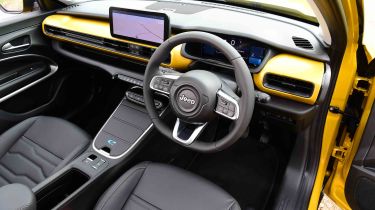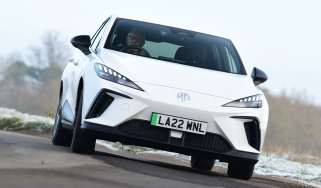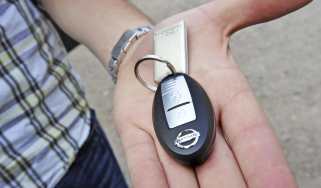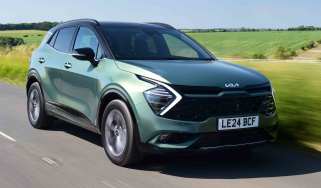Jeep Avenger - Interior, design and technology
The Jeep Avenger looks great and features iconic Jeep design cues and ‘easter eggs’ all over the exterior and interior

The design team’s brief for the Avenger was to fit “100 per cent of the brand DNA into four metres”, and frankly, they nailed it – even from 100 feet away, you know this is a Jeep. While other small SUVs feature curvaceous bodywork or a swooping roofline to look futuristic or help with aerodynamics, the Avenger has an unashamedly chunky and squared-off shape with a broad, planted-looking stance to give it more attitude.
At the front is an evolution of Jeep’s iconic seven-slot grille, and overall, the Avenger does have a slightly aggressive face. But because of just how small it is, it reminds us of a puppy that enjoys growling at the postman in the morning.
There’s extensive cladding along the side of the car and the wheel arches, which give it the essence of a rugged off-roader and have the additional benefit of being more resistant to knocks and scuffs. The rear is simple, with more black plastic and tail lights with an X-shaped motif.
Jeep has also hidden lots of ‘easter eggs’ around the Avenger, including lots more seven-slot-grille motifs on the rims and front air intake, and a small illustration of the designer's son looking through a telescope at the stars in the corner of the windscreen.
More reviews
Car group tests
- Skoda Kamiq vs Jeep Avenger: which small SUV is mightiest?
- Jeep Avenger vs Kia Niro EV vs Volkswagen ID.3: low-cost compact EVs duke it out
- Jeep Avenger vs Mazda MX-30: left-field electric SUVs face off
In-depth reviews
Long-term tests
Road tests
There are many paint colours for buyers to choose from, including two-tone schemes like our test car's Sun yellow and Volcano black roof. Opting for this particular combo also gives you the option of a yellow dashboard, which brightens up the cabin. However, you have to go for the yellow and black paint, and top-spec Summit trim, to unlock that as an option, which is a shame because we bet many customers would pay to inject a bit more colour into the already quite funky cabin.
Thankfully, Jeep offers plenty of other accessories to help distinguish your Avenger from the rest, including graphics for the bonnet and grille, 18-inch wheels with blue accents, and the usual assortment of roof racks and rubber mats for the boot and footwells for more outdoorsy owners.
What is the Jeep Avenger like inside?
Inside, the cabin uses chunky toggle buttons on the dashboard, and a number of big buttons on the steering wheel and centre console. We’re not too fond of the interior light controls on the roof, though, because the unit looks like it came from the decade-old Fiat Panda.
While we approve of the use of physical buttons in the Avenger to control frequently used features, such as the climate control, we prefer the simpler dial set-up used in the Kamiq. However, making small adjustments in the Avenger is still less distracting compared to the Puma, which has gone all in on touchscreen controls.
What is the interior quality like?
The swathes of hard plastic inside the Avenger may be rugged and reasonably hard-wearing, but it lacks the premium feel of something like the Skoda Kamiq, which uses more soft touch materials and has controls that emit a satisfying click, and buttons that have that typical Volkswagen feel of being well damped.
Sat-nav, stereo and infotainment
The Avenger’s infotainment system is a significant improvement on older Jeep tech. The larger 10.25-inch screen we’ve tried so far is a good size, and it’s responsive. Standard-fit wireless Apple CarPlay and Android Auto ensure buyers can utilise apps from their phones. There’s a large storage cubby that lives below a row of climate controls, and there’s a proper volume dial for the audio system. There are physical ‘home’ and ‘settings’ buttons located just below the touchscreen; however, they’re small and not illuminated, so it may take a while to develop the muscle memory required to find these at night.










